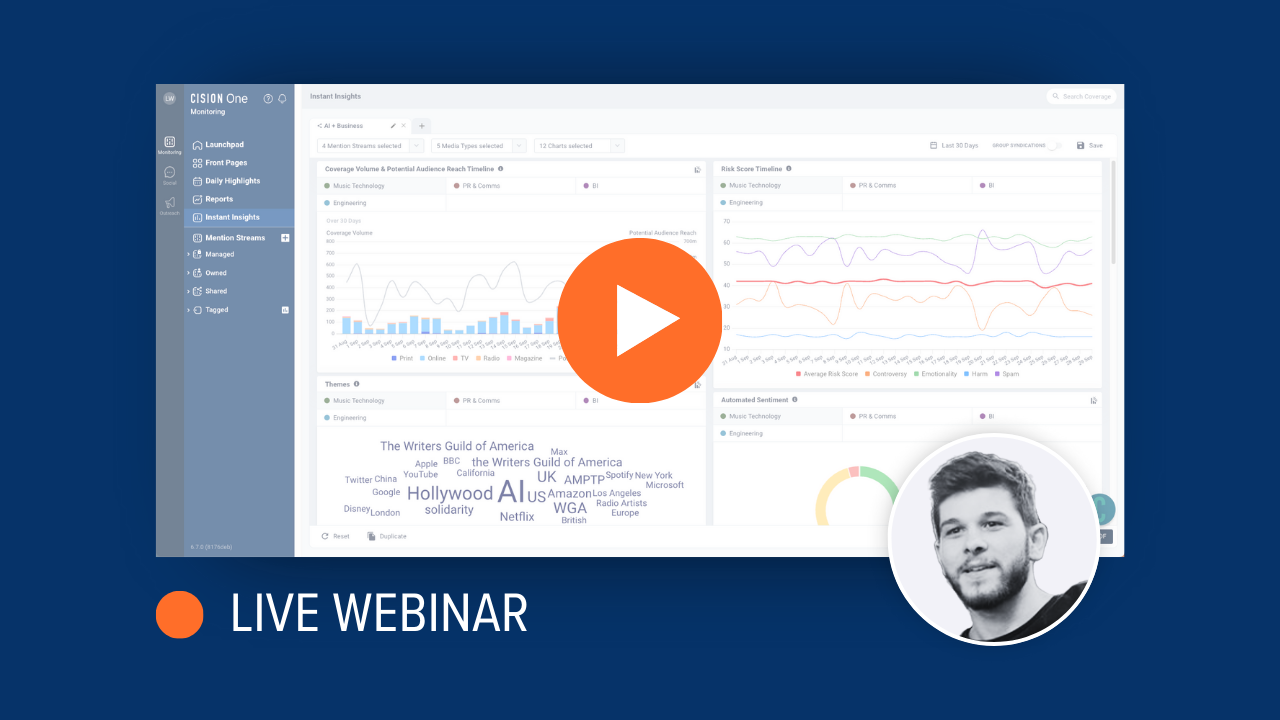
For the seventh year running, Cision and PRWeek have joined forces for the Global Comms Report, a collaboration that looks at the biggest challenges and opportunities PR and communications industry professionals face right now.
This year’s survey saw 427 senior industry professionals from across 10 countries take part to give a snapshot of shifting and emerging trends, and what they mean for communicators moving forward.
So what can we learn from the data? The Global Comms Report is available to download now, but if you need a quick primer we’ve sifted through the results to bring you five key takeaways.
1. Higher Expectations on PR & Comms Teams to Move the Business Needle
This year’s Global Comms Report found that 92% of communications leaders report that the C-suite is seeking their counsel more than in previous years. With increased visibility and influence, now there’s an expectation for them to impact their companies’ and clients’ bottom lines.
When asked to choose the factors they believe to be comms’ biggest priorities in the eyes of their CEOs, “building sustainable growth and value for the brand” came out on top. Sixty percent of respondents placed this factor in their top four this year, compared to 54% who did the same last year. Other top-ranking priorities include “customer acquisition/engagement,” cited by 43% of respondents (and up from 34% who said the same last year), and “driving sales/revenue,” cited by 42% of respondents (against 33% last year).
Sarah O’Grady, SVP of marketing for Cision and Brandwatch, notes in the report that comms teams now have the tools to measure the impact of their efforts, making them valuable to the C-suite. “They now expect their comms teams to be able to track and report out on data at a much more real-time and granular level than ever before,” she says. “They also realise that reliable, authentic communication is essential for building consumer trust and managing brand reputation. Therefore, it is critical to acquiring and retaining customers.”
2. Back to the Office? PR Teams Embrace Hybrid Work
Almost four years on from the Covid pandemic, PR professionals are now firmly settled into a new rhythm of work. Global results show that 57% of respondents are hybrid working (part in-office, part remote), with 29% fully remote and 14% now completely back at their office desks.
However, there’s a contrast in working arrangements when looking across regions. In the U.S., 63% reported they were working in a hybrid fashion, while in Europe that figure was 58%. The APAC region is far lower at 40%, while 23% in the same region say they are back into the office full time. That’s more than double the U.S. and Europe, with both regions registering 11% as back in the office. Interestingly, more APAC respondents also report working fully remote (37%) as opposed to staff in Europe (31%) and the U.S. (26%).
Tara Darrow, VP of corporate and financial communications, values and reputation and executive brand at T-Mobile, is quoted in the report saying her team have largely returned to the office – something she views as vital for collaboration. “Depending on the level, people on my team are in three-plus or four-plus days,” she says. “You need face time to enhance creativity. As for areas such as crisis, on-the-spot problem-solving is critical. Trying to do that without the person right in front of you is really, really hard.”
3. Everyday Consumers Outperform Celebrity Influencers
Pinpointing the right influencers to partner with can’t be left to instinct anymore. Traditionally, celebrities and those with a sizable social media following have found favour, but according to this year’s Global Comms Report, it’s consumers who hold the most sway.
Of this year’s survey respondents, “everyday consumers” rank the highest (57% placed among the top three globally) in terms of potential influencer effectiveness. These individuals might include everyone from the people who leave reviews on Amazon to the Facebook friends you take product recommendations from. Corporate executives and employees (both placed in the top three globally by 44%) and micro-influencers (42%) have both grown since last year, while celebrities are notably down this year (36% placed among the global top three) in terms of perceived impact on consumer behaviour.
Nick Cowling, CEO at Citizen Relations, says in the report that although celebrities are “the original influencers” and still have a role to play, consumers are becoming “pretty savvy about understanding when a celebrity is pushing something because they’re being paid to do it.” He adds: “Niche or micro-influencers, though, are more open about sponsorship in that regard and [willing] to say, ‘I am doing this sponsorship because I’ve used this product before.’”
4. Social Media Shifts In a Post-Twitter World
Decisions about which social media channels to prioritise are critical for a brand’s overall strategy. For comms teams with limited resources, it’s particularly key to target platforms that will resonate the most with their intended audiences.
In this year’s Global Comms Report, respondents were asked to choose the four platforms they deem most valuable to their broader strategy. Globally, Facebook emerged in first place with 73% placing it in their top four, followed by Instagram (71%), LinkedIn and YouTube (52%).
In this year’s most notable change, X (formerly Twitter) fell from 50% in 2023 to 36% this year, making it the sixth most popular social platform, falling just behind TikTok (at 37%, up from 33% last year).
Looking at the data by individual regions, however, LinkedIn takes the top spot in the U.S. (placed in the top four by 86% of respondents), though Facebook remains the top channel in APAC (by 66%) and Europe (71%).
Facebook has remained a strong performer in every Global Comms Report. In the very first edition back in 2017, it was chosen among the top four platforms by 77% of respondents. That put it far ahead of the second-highest choice – Twitter at 55%. (Instagram was 38%; LinkedIn was 24%; and YouTube was 16%). Now the gap between Facebook and the second most popular platform (Instagram) has reduced considerably. 2024 could be the year Instagram rises to the top, and the platform once known as Twitter becomes a distant memory.
5. Are PR Teams on Board with Generative AI?
Artificial Intelligence (AI) has filtered into many industries and sectors over the last 12 months, and PR and comms is no different. It’s true that the technology has been the backbone of sentiment analysis for more than a decade, but generative applications like ChatGPT have opened the doors to content creation at speed and scale.
But to what extent have PR and comms professionals brought generative AI into their workflows? According to this year’s Global Comms Report, 32% of respondents say they use it frequently, 33% use it infrequently, 27% are considering starting to experiment with it, 7% are unlikely to use and 1% aren’t sure about usage yet. There are sharp differences across the regions in terms of usage, though. In Europe, 42% say generative AI is being used frequently, while in APAC that number is 31% and just 24% in the U.S..
Of the potential use cases, the most popular among our global respondents was research, where 42% of respondents said they were “experimenting with generative AI, but not using it with any regularity.” This is an indication that the industry is still in its early stages when it comes to widespread generative AI adoption.
This data is just the start. To learn more about the evolving comms landscape, download the full 2024 Global Comms Report.
To learn about the solutions available to help you apply these findings to your comms strategy, speak to one of our experts.
Most Recent Posts
Cision Resources
-
E-books and Guides
Comprehensive how-to guides on strategy and tactics
-
Case Studies
What are other brands doing – and how can we learn from them?
About Simon Reynolds
Simon is the Senior Content Marketing Manager at Cision. He worked as a journalist for more than a decade, writing on staff and freelance for Hearst, Dennis, Future and Autovia titles before joining Cision in 2022.
Learn More. Do More. demo new
PR Tips, Case Studies, and Product Updates

[On-Demand Webinar] The Next Generation of Media Intelligence: From Gorkana to CisionOne
Explore CisionOne, a revolutionary media intelligence platform, and the evolution of Gorkana. Learn key features and strategies from Luke Williams, CisionOne Product Marketing Manager. Elevate your media outreach to new heights!


